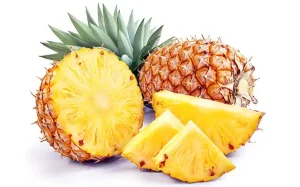Pineapples are delicious tropical fruits that can be enjoyed in various ways – from fresh slices to juice and even as a topping on pizza! But have you ever wondered how these sweet and tangy fruits grow? This guide will take you through the process of growing your own pineapple plant and harvesting its juicy fruits.

Growing Pineapples Plant
Preparation
– Fresh pineapple fruit: Get a pineapple from the supermarket or your local tropical fruit vendor. Look for a pineapple that is ripe and has healthy-looking leaves.
– A pot: Prepare a clay or terracotta potting container, which is small at first (about 8 inches in height).
– A sharp knife: A sharp one is necessary to twist off the crown, trim or remove any excess needed
– Potting soil: Choose an organic potting mix of sand and peat is acceptable.
Step for direct growing
Step 1: Once you have your pineapple, use a sharp knife and cut away the top of the pineapple, about an inch below the foliage.
Step 2: Trim the excess: continue trimming unused parts like redundant flesh, leaves at the top and suckers. The bottom of the stem also needed to be removed.
Step 3: After removing the top, let it sit in a cool, dry place for a few days to allow the cut end to dry. This will help prevent rot when you plant the pineapple top.
Step 4: Once the cut end has dried, prepare a pot and fill it with soil, leaving some space at the top. Take the top and gently press it into the soil, ensuring the cut end is covered. Firmly press the soil around the base of the leaves and top to secure it in place.
Note: Ensure the pot has a drainage hole at the bottom, and the soil is well-draining.
Step 5: Water the pineapple plant thoroughly after planting to keep the soil slightly moist but not soggy. Place the pot in a sunny location, as pineapples thrive in bright sunlight. Within a few weeks, another pineapple roots form, indicating successful growth.
Using Pineapple Crown to Grow
Another way to plant pineapple is by rooting a pineapple crown. Here are the following easy steps to process:
Step 1: After enjoying a delicious pineapple, save the crown by carefully cutting it off from the remaining fruit. Remove any excess fruit flesh from the crown, keeping the lower leaves intact.
Step 2: Plant the pineapple crown in a glass of water, ensuring the bottom inch of the crown is submerged. Change the water every few days to prevent it from turning stagnant. After a couple of weeks, small pineapple roots start growing from the bottom of the crown.
Step 3: Once the roots are well established, you can transfer the crown to a pot with well-draining soil.
Step 4: Follow the same planting instructions mentioned earlier, and your pineapple plant will continue growing and producing fruit.
Growing Indoors
If you live in a colder climate or don’t have an outdoor garden, you can still grow a pineapple plant inside the house. The process is similar to planting a pineapple outside but with a few modifications.
Step 1: Choose a smaller pot that comfortably accommodates the pineapple top and ensures good drainage.
Step 2: Place the pot in a sunny spot near a window where the plant can get at least six hours of sunlight daily. If natural light is insufficient, you can use artificial grow lights to supplement the daylight. Make sure to rotate the pot occasionally to ensure even growth.
Step 3: Indoor pineapple plants can benefit from regularly applying a balanced fertilizer. Consult with your local garden center to find a suitable fertilizer and follow the instructions for application. It’s important to note that over-fertilizing can damage the plant, so always use fertilizer in moderation.

Harvesting Pineapples
Time to harvest
Usually, pineapple plants grow in 24-36 months total amount of time, at least over a year to get a mature fruit from the starting time of planting. This can vary based on the environmental conditions we deliver to them during the process.
After patiently growing your pineapple plant, the exciting part finally arrives – harvesting the ripe fruit. But how can you tell if your pineapples are ready to be picked? There are a few signs to look out for:
The color of the pineapple fruit is one indicator of its ripeness. Most pineapples start with green leaves and gradually turn golden yellow as they mature. Look for a pineapple with vibrant yellow skin and avoid picking it if the skin is still mostly green. Besides, the brown color also indicates the fruit is overripe.
In addition to color, the aroma of the pineapple is another clue. Ripe pineapples have a sweet and tropical scent. If you notice a strong, sweet smell around your pineapple plant, it indicates that the fruit is ready for harvest.
Lastly, gently tug on one of the inner leaves in the center of the pineapple crown. If the leaf comes out quickly, the pineapple is ripe and ready to be enjoyed.
Harvesting
When harvesting your pineapple, cut the fruit off the plant with a sharp knife. Hold the pineapple with one hand and carefully cut the stalk as close to the fruit as possible. Be cautious while mowing to avoid any injury.
After harvesting the pineapple, it’s important to remove any remaining fruit flesh from the top of the pineapple. This will prevent residual fruit from rotting and harming the newly harvested fruit.
Once you have your ripe fruit, it’s time the pineapples get ready to enjoy. Slice it up into juicy wedges, blend it into a refreshing smoothie, or create mouthwatering tropical dishes – endless possibilities. Besides, the fresh fruit can be processed into dried pineapples, packed in convenient plastic bags, and easily stored.
Troubleshooting common issues when planting pineapple
Common Issues
While growing pineapples can be a rewarding experience, it’s challenging. Here are some common issues you may encounter and how to deal with them.
Turning brown
One common problem is the yellowing or browning of pineapple leaves. This can be caused by overwatering, underwatering, or inadequate sunlight. Adjust the watering schedule and ensure the plant gets enough light to prevent leaf discoloration.
Frost
Frost can also concern outdoor pineapple plants in colder climates, especially the first frost. If you live in an area prone to ice, it’s essential to remove your pineapple plant indoors or cover it with a frost blanket when temperatures drop.
Ensuring growing conditions
It would help if you gave them the proper care and attention to keep your pineapple plant growth healthy. You will need to provide it with the right conditions to thrive as below:
Temperature
Pineapples grow in direct sunlight and prefer warm temperatures and humidity, similar to their natural habitat. Keep your houseplant pineapple in an area with temperatures between 70-85°F (21-29°C) and humidity levels around 50-70%.
Water
Regularly check the water as needed, and also water your pineapple regularly, making sure the soil is evenly moist. Avoid overwatering, as pineapples are prone to root rot if the soil becomes waterlogged. If the leaves of your pineapple start turning yellow or brown, reduce the amount of water you are giving it.
Pineapple plants require well-draining soil, so ensure that excess water can easily drain out of the pot.
Humidity
Pineapple plants also benefit from occasional misting to increase humidity levels. Fill a spray bottle with water and mist the leaves of the plant, paying extra attention to the underside of the leaves. This will moisten the pineapple plants.
Fertilizer
A balanced fertilizer formulated explicitly for fruiting plants can help promote healthy growth and increase fruit production. Follow the instructions on the fertilizer packaging for the correct dosage and frequency of application.
Pests or diseases
Lastly, keep an eye out for any signs of pests or diseases. Common pests affecting pineapple plants include mealybugs, scale insects, and spider mites. If you notice any infestations, treat them promptly with organic insecticides or consult a local garden center for suitable control methods.
Conclusion
With proper care and patience, you can have your own pineapples plant to grow and enjoy harvesting fresh, juicy fruits. Whether you plant them indoors or outdoors, following this step-by-step guide will ensure a bountiful harvest of delicious pineapples.
